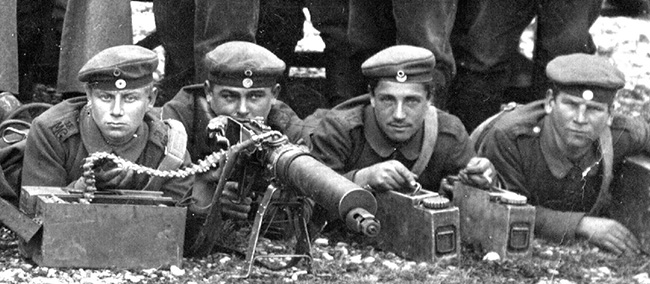“Soon there stood a light or heavy machine gun behind every transverse traverse. I placed myself behind one of these bullet splitters and fired until my finger was blackened by smoke. When the cooling water was evaporated the boxes were passed around and refilled – accompanied by indecent jokes – by a very simple method.” (source 1: Ernst Jünger: In Stahlgewittern)
Already in autumn 1914 the German advance came to a hold. The failure of the Schlieffen Plan that lead to the standstill of the frontline, caused a chance in the conduct of war: Repeated and growing offensives grew into gigantic battles of material, where massive artillery fire was used to destroy the complex systems of trenches heavily protected by wire and tripping hazard used by both sides.
This type of warfare had an impact on the equipment of the soldiers. In the trenches modern melee weapons mingled with archaic assuming spades, daggers and spiked clubs – crafted by the soldiers but also industrial produced as “Grabenkeule”. Apart from the artillery the automatic weapons caused the worst injuries. Among the German troops they have been the main cause of deaths and injuries. With this the transformation towards the age of mechanized war took place during the First World War that tended to become a “total war” through the mobilization of all industrial resources. The efficiency and innovative capability of nations increasingly became a relevant factor in the war
(source 2).
With a rate of fire of approximately 500 rpm the use of machine guns meant a tremendous increase in fire rate which made the tactical use of cavalry obsolete
(source 3).
In the battles of Flanders the infantryman still had been unprotected against machine guns. Later all armies introduced steal helmets as protective against shrapnels and projectiles and equipped advanced posts with steal breastplates.

Bavarian field machine gun troop 18
Another automatic weapon was used in the later war in correspondence to the changed tactics among German troops. Since 1917 assault companies and battalions have been formed, who operated with the shock troop tactics: covered by only a short artillery strike they aimed to pass wire entanglements and trenches rapidly. The abandonment of a long artillery phase aimed at not to warn the enemy and prevent that fresh troops could be brought forward. These elite troops have been equipped, among other gear, with the Bergmann-Maschinenpistole MP18 to enhance their fighting strength in the trench warfare. This 5.2 kg weighing weapon had a magazine with 32 rounds. Until November of 1918 30,000 units had been produced and half that number made its way to the front. This first real submachine gun was used during the spring offensive in 1918. The almost mystical fame as „Grabenfeger“ (trans.: trench - cleansener) was one reason for the ban of the production of automatic weapons in Germany in the Treaty of Versailles (source 6).
Uwe Fraunholz, Dresden 2015
Bibliography- Peter Berz: 08/15. Ein Standard des 20. Jahrhunderts, München 2001.
- Michael Epkenhans: Kriegswaffen – Strategie, Einsatz, Wirkung, in: Rolf Spilker, Bernd Ulrich (Hg.): Der Tod als Maschinist. Der industrialisierte Krieg 1914–1918, Bramsche 1998, S. 69-83.
- Laurent Mirouze: Infanteristen des Ersten Weltkriegs, Düsseldorf 1990.